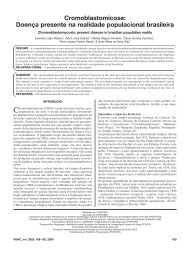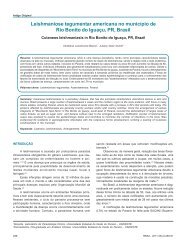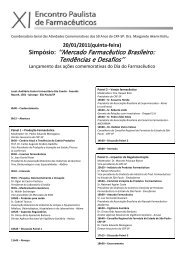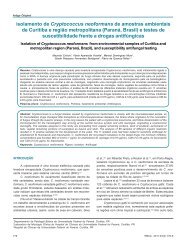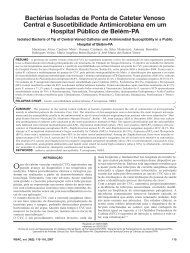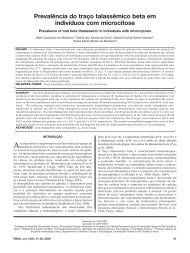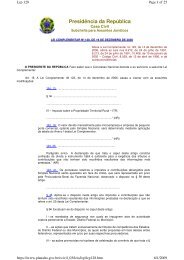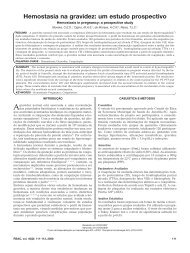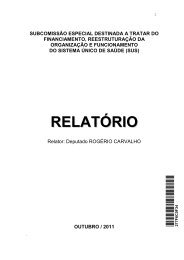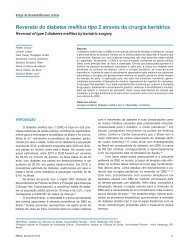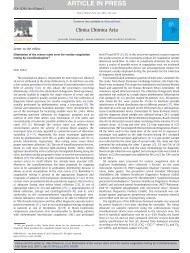Suitability of a transport box for blood sample shipment over a long ...
Suitability of a transport box for blood sample shipment over a long ...
Suitability of a transport box for blood sample shipment over a long ...
You also want an ePaper? Increase the reach of your titles
YUMPU automatically turns print PDFs into web optimized ePapers that Google loves.
Clinical Biochemistry 44 (2011) 1028–1029<br />
Contents lists available at ScienceDirect<br />
Clinical Biochemistry<br />
journal homepage: www.elsevier.com/locate/clinbiochem<br />
Case Report<br />
<strong>Suitability</strong> <strong>of</strong> a <strong>transport</strong> <strong>box</strong> <strong>for</strong> <strong>blood</strong> <strong>sample</strong> <strong>shipment</strong> <strong>over</strong> a <strong>long</strong> period<br />
Giuseppe Lippi a, ⁎, Gabriel Lima-Oliveira b,c,d,e , Sandro Coutino Nazer d , Maria Luiza Lopes Moreira d ,<br />
Rodrigo Fagner Macedo Souza d , Gian Luca Salvagno c , Martina Montagnana c , Marileia Scartezini b ,<br />
Geraldo Picheth b , Gian Cesare Guidi d<br />
a U.O. Diagnostica Ematochimica, Azienda Ospedaliero-Universitaria di Parma, Parma, Italy<br />
b Program <strong>of</strong> Pharmaceutical Sciences, Department <strong>of</strong> Medical Pathology Federal University <strong>of</strong> Parana, Curitiba, Parana, Brazil<br />
c Sezione di Chimica Clinica, Dipartimento di Scienze della Vita e della Riproduzione, Università degli Studi di Verona, Verona, Italy<br />
d MERCOSUL: Sector Committee <strong>of</strong> Clinical Analyses and in Vitro Diagnostics – CSM 20, Rio de Janeiro, Brazil<br />
e Brazilian Society <strong>of</strong> Clinical Analyses on Sao Paulo State, Brazil<br />
article<br />
info<br />
abstract<br />
Article history:<br />
Received 12 April 2011<br />
Received in revised <strong>for</strong>m 25 May 2011<br />
Accepted 27 May 2011<br />
Available online 13 June 2011<br />
Keywords:<br />
Preanalytical variability<br />
Laboratory errors<br />
Storage<br />
Transportation<br />
Quality<br />
Background: Safety <strong>transport</strong> <strong>box</strong>es are increasingly used to ship laboratory specimens but there is little<br />
in<strong>for</strong>mation on their capacity to maintain suitable <strong>transport</strong>ation temperatures.<br />
Materials and methods: Inner temperature was assessed using a commercially available <strong>transport</strong> <strong>box</strong><br />
during an 8-h <strong>transport</strong>ation period in the heat.<br />
Results: Temperature stability was unsatisfactory during approximately 64% <strong>of</strong> the <strong>transport</strong>ation time (i.e.,<br />
from 125 to 450 min).<br />
Conclusions: Transport <strong>box</strong>es might be unsuitable <strong>for</strong> shipping specimens <strong>over</strong> <strong>long</strong> periods.<br />
© 2011 The Canadian Society <strong>of</strong> Clinical Chemists. Published by Elsevier Inc. All rights reserved.<br />
Introduction<br />
Although laboratory diagnostics strongly contributes to the<br />
screening, diagnosis, follow-up and therapeutic monitoring <strong>of</strong> most<br />
— if not all — human disorders, diagnostics errors can occur at any step<br />
<strong>of</strong> the total testing process, i.e., from the appropriateness <strong>of</strong> the test<br />
request to the interpretation <strong>of</strong> test results [1]. Within this cycle (i.e.,<br />
the <strong>for</strong>emost Lundberg's “brain to brain turnaround cycle”), errors<br />
arising from the manually intensive preanalytical activities are<br />
prevailing, representing up to 70% <strong>of</strong> all laboratory errors. Preanalytical<br />
errors are mostly due to incorrect, inappropriate or mishandled<br />
procedures <strong>for</strong> collection, handling, preparation and — last but not<br />
least — <strong>transport</strong>ation and storage <strong>of</strong> the specimens [2–4]. In<br />
particular, due to the widespread networking, centralization <strong>of</strong><br />
laboratory diagnostics within large facilities (e.g.., huge, totally<br />
automated and focused factories) and the consequent need to<br />
<strong>transport</strong> a large number <strong>of</strong> specimens from peripheral collections<br />
sites to the core laboratories, the problem <strong>of</strong> appropriate conditions <strong>of</strong><br />
<strong>sample</strong> <strong>transport</strong>ation (i.e., time, temperature and humidity) is<br />
critically emerging [5,6]. More<strong>over</strong>, temperature monitoring is<br />
considered one <strong>of</strong> the leading issues in transfusion medicine, since<br />
⁎ Corresponding author at: U.O. Diagnostica Ematochimica, Azienda Ospedaliero-<br />
Universitaria di Parma, Via Gramsci, 14, 43126-Parma, Italy. Fax: +0039 0521 703791.<br />
E-mail addresses: ulippi@tin.it, glippi@ao.pr.it (G. Lippi).<br />
routine <strong>blood</strong> components' <strong>transport</strong>ation should not exceed 10 °C<br />
during <strong>transport</strong> at a maximum transit time <strong>of</strong> 24 h, as established by<br />
most guidelines [7]. Safety <strong>transport</strong> <strong>box</strong>es, that are products<br />
designed to maintain the inner environment at a constant temperature<br />
notwithstanding temperature changes outside the container,<br />
are increasingly developed and used to store and ship laboratory<br />
specimens as well as other biological materials. Nevertheless, little<br />
in<strong>for</strong>mation is available as yet on the effectiveness <strong>of</strong> these devices to<br />
maintain suitable conditions <strong>of</strong> temperature, which would not affect<br />
<strong>sample</strong> quality during <strong>long</strong> <strong>transport</strong>ation times.<br />
Materials and methods<br />
<strong>Suitability</strong> <strong>of</strong> <strong>sample</strong> <strong>transport</strong>ation was assessed using a commercially<br />
available <strong>transport</strong> <strong>box</strong>, purchased from Coleman® (Wichita, Kansas–<br />
United States) with exterior size: 10.63″L×7.87″W×8.27″H, and interior<br />
size: 9.45″L×6.89″W×7.09″H. To warrant the correct temperature range,<br />
four ice reusable dry gel packs with carbopol gel inside (2×200 mL and<br />
2×500 mL) were accurately placed inside the <strong>transport</strong> <strong>box</strong> at a private<br />
peripheral <strong>blood</strong> collection facility. A calibrated temperature recorder<br />
(Trix-8 Temperature Recorder®, LogTag recorders, Adarve®, Brazil) was<br />
also inserted. The temperature monitoring was started immediately<br />
after closure <strong>of</strong> the <strong>box</strong> and repeated every 5 min through an 8-hour<br />
study period. According to manufacturer's instruction, the suitable<br />
<strong>transport</strong>ation temperature (i.e., below 10 °C) is reached ~30 min after<br />
0009-9120/$ – see front matter © 2011 The Canadian Society <strong>of</strong> Clinical Chemists. Published by Elsevier Inc. All rights reserved.<br />
doi:10.1016/j.clinbiochem.2011.05.028
G. Lippi et al. / Clinical Biochemistry 44 (2011) 1028–1029<br />
1029<br />
Fig. 1. Fluctuation <strong>of</strong> the inner temperature <strong>of</strong> a <strong>transport</strong>ation <strong>box</strong> during the 8-h study period.<br />
closure <strong>of</strong> the <strong>box</strong>, so that <strong>transport</strong>ation from the private facility to the<br />
core laboratory by courier as per manufacturer requirements started at<br />
this time point. After 7 h and 30 min <strong>of</strong> <strong>transport</strong>ation the <strong>box</strong> arrived<br />
at the destination, in the core laboratory. Temperature data were<br />
further analyzed with LogTag Analyser®. The limit <strong>of</strong> suitable<br />
temperature fluctuation was established between 2 °C and 8 °C (i.e.,<br />
35.6 °F—46.4°F), in agreement with the current recommendations <strong>of</strong> the<br />
Clinical and Laboratory Standard Institute (CLSI) [8]. The environmental<br />
temperature during <strong>transport</strong>ation was comprised between 36 °C and<br />
38 °C, whereas that <strong>of</strong> the private facility and the core laboratory was<br />
~20 °C.<br />
Results<br />
The fluctuation <strong>of</strong> the temperature within the <strong>transport</strong> <strong>box</strong> during<br />
the 8-h study period is shown in Fig. 1. Thirty minutes after the closure<br />
<strong>of</strong> the <strong>box</strong> at the private facility the temperature rapidly fell from room<br />
temperature (i.e., ~20 °C) to 6 °C, in agreement with manufacturer's<br />
claim. After beginning <strong>of</strong> <strong>transport</strong>ation, a nearly linear increase <strong>of</strong><br />
temperature was then observed, exceeding the upper suitable limit (i.e.,<br />
8 °C) after 120 min (i.e., 90 min from the beginning <strong>of</strong> <strong>transport</strong>ation).<br />
Twenty min after arrival at the core laboratory, the internal temperature<br />
<strong>of</strong> the <strong>transport</strong> <strong>box</strong> dropped down at 7 °C. As such, temperature<br />
stability could be considered unsatisfactory during approximately 64%<br />
<strong>of</strong> the <strong>transport</strong>ation time, i.e., from 125 to 450 min.<br />
Discussion<br />
The increasing centralization <strong>of</strong> laboratory facilities has raised<br />
important economical, organizational and preanalytical issues such as<br />
the escalation <strong>of</strong> costs, the <strong>long</strong>er <strong>transport</strong>ation times and the<br />
potential increase <strong>of</strong> preanalytical errors due to the <strong>of</strong>ten challenging<br />
conditions <strong>of</strong> <strong>transport</strong>ation and storage <strong>of</strong> the specimens [5,6].<br />
Establishment and maintenance <strong>of</strong> appropriate temperatures <strong>for</strong><br />
<strong>transport</strong>ation is essential <strong>for</strong> preserving the quality <strong>of</strong> whole <strong>blood</strong><br />
and even centrifuged specimens, thus preventing irreversible physicochemical<br />
alterations <strong>of</strong> <strong>blood</strong> components. According to the current<br />
recommendations <strong>of</strong> the CLSI, chilled <strong>blood</strong> specimens should be<br />
maintained at temperatures comprised between 2 °C and 8 °C until<br />
separation [8]. As such, the <strong>transport</strong>ation <strong>of</strong> <strong>sample</strong>s and <strong>blood</strong><br />
components is increasingly accomplished by safety <strong>transport</strong> <strong>box</strong>es,<br />
especially in countries with high or even extreme environmental<br />
temperatures and where <strong>shipment</strong> might occur <strong>over</strong> <strong>long</strong> distances.<br />
Nevertheless, no published data are available to the best <strong>of</strong> our<br />
knowledge on the per<strong>for</strong>mance <strong>of</strong> <strong>transport</strong>ation <strong>box</strong>es as regards<br />
temperature stability throughout <strong>long</strong> periods <strong>of</strong> <strong>transport</strong>ation, up to<br />
several hours. Although limited to the evaluation <strong>of</strong> a single<br />
commercial product the results <strong>of</strong> this investigation attest that the<br />
recommended temperature <strong>for</strong> <strong>transport</strong>ation (i.e., between 2 °C and<br />
8 °C) might only be maintained <strong>for</strong> a limited period <strong>of</strong> time within a<br />
<strong>transport</strong> <strong>box</strong> (e.g., up to 90 min), because the internal temperature<br />
might be dramatically influenced by the environmental conditions. As<br />
such, we hypothesized that some <strong>of</strong> these products might be<br />
unsuitable to fulfil the requirements <strong>of</strong> some peripheral facilities<br />
integrated within a network, especially those which ship the<br />
specimens to very distant core laboratories. Rather understandably,<br />
although all the experimental conditions were accurately standardized,<br />
replication <strong>of</strong> this study at different temperature (e.g., high or<br />
even extreme external temperatures) or humidity, as well as the use<br />
<strong>of</strong> different types <strong>of</strong> containers made on different materials, might<br />
provide different outcomes, so that additional studies should be<br />
planned to test this hypothesis.<br />
References<br />
[1] Plebani M, Lippi G. To err is human. To misdiagnose might be deadly. Clin Biochem<br />
2010;43:1–3.<br />
[2] Lippi G, Guidi GC, Mattiuzzi C, Plebani M. Preanalytical variability: the dark side <strong>of</strong><br />
the moon in laboratory testing. Clin Chem Lab Med 2006;44:358–65.<br />
[3] Lippi G. G<strong>over</strong>nance <strong>of</strong> preanalytical variability: travelling the right path to the<br />
bright side <strong>of</strong> the moon? Clin Chim Acta 2009;404:32–6.<br />
[4] Lima-Oliveira G, Picheth G, Sumita NM, Scartezini M. Quality control in the<br />
collection <strong>of</strong> diagnostic <strong>blood</strong> specimens: illuminating a dark phase <strong>of</strong> preanalytical<br />
errors. J Bras Patol Med Lab 2009;45:441–7.<br />
[5] Plebani M, Lippi G. Is laboratory medicine a dying pr<strong>of</strong>ession? Blessed are those<br />
who have not seen and yet have believed. Clin Biochem 2010;43:939–41.<br />
[6] Plebani M, Lippi G. Focused factories and boutique laboratories. The truth might lie<br />
in between. Clin Biochem 2010;43:1484–5.<br />
[7] Klose T, Borchert HH, Pruss A, Roth WK, Bohnen HR, Putzker M. Current concepts<br />
<strong>for</strong> uality assured <strong>long</strong>-distance <strong>transport</strong> <strong>of</strong> temperature-sensitive red <strong>blood</strong> cell<br />
concentrates. Vox Sang 2010;99:44–53.<br />
[8] Clinical and Laboratory Standard Institute. Procedures <strong>for</strong> the Handling and<br />
Processing <strong>of</strong> Blood Specimens; Approved Guideline—Fourth Edition. CLSI document<br />
H18-A3940 West Valley Road, Suite 1400, Wayne, Pennsylvania 19087 1898<br />
USA: Clinical and Laboratory Standards Institute1-56238-724-3; 2010.



